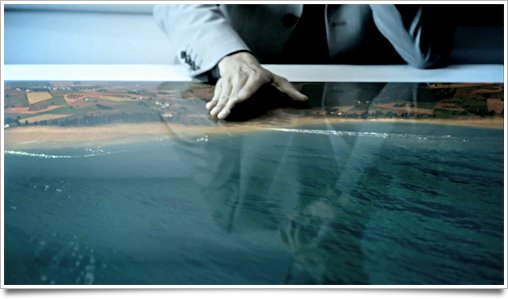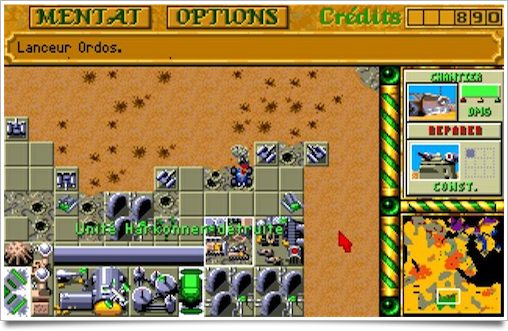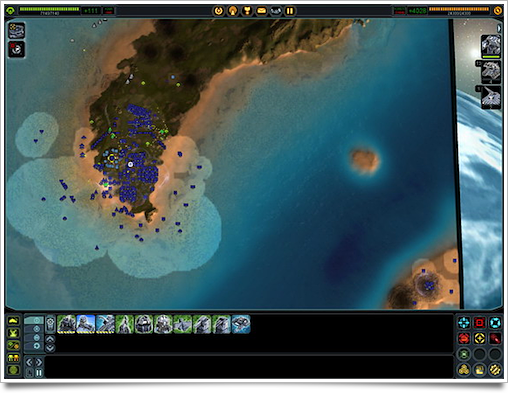RTS, or Real-time strategy games, have been with us since the birth of the first games that ever graced computer screens.
With some recent client work, I’ve been doing quite a bit of homework on strategy game interfaces; I dug out all my old games, played and screen-captured over two dozen game interfaces, mocked up a massive amount of approaches to problems, and talked with some friends in the gaming industry. As a UI designer, I’m fascinated to see how it’s developed in the last 20 years and in which direction it is now headed.

It’s quite interesting to look not just at where we’re heading, but also where we’ve come from. Since the invention of chess and other similar strategic board games, it’s clear that people love the tactile experience that manipulating ‘units’ gives. However, with today’s world of massive virtual representations of battlefields, this feeling has been diluted significantly. The relevant question for me is, obviously, how multi-touch devices like the iPhone can bring back the sweaty palms and rush that you experience forward the first pawn in a game of chess.
I’m not sure if you’ve ever tried playing a strategy game on the iPhone, but most of them aren’t very usable. Modern strategy games typically require a very large amount of screen real estate to show interface elements, and even then use diverse solutions to compress information into smaller areas while allow for a large area in which you can command your units.
A nice example of taking this tradeoff into consideration is Dune 2.

Dune 2 was released in 1992 by Westwood Studios. Westwood is famous for the Command & Conquer series, but Dune really kicked off their defining series of RTS games. It was also the first strategy game that allowed you to command units with the mouse, as opposed to traditional controller or keyboard input. The mouse soon dominated the strategy game world, and I grew up with games like Command & Conquer: Red Alert, Starcraft, Dark Reign, and my personal favorite: Total Annihilation. These games could all be played with nothing but a mouse; as far as I’m aware, only Total Annihilation used keyboard modifier keys to allow more complex commands with the mouse.
Between then and now, large strategy game titles have followed existing conventions, but have advanced significantly in terms of graphics and scale. Interaction-wise, the mouse scroll wheel was standardized. Then came 2007: I was delighted to see that Chris Taylor, who once led the development of Total Annihilation, released Supreme Commander. Supreme Commander follows in TA’s footsteps, but the scale of its battles is somewhat more massive. However, the scale, graphics, or graphic design weren’t the most interesting aspects to me. What Supreme Commander astonished me with was unifying the traditional minimap, a small representation of the battlefield, with the actual view of the battlefield.

Essentially, Supreme Commander introduced the Zoomable User Interface to the strategy game genre. The user could seamlessly zoom in and out of the action to get a birds’-eye view of the situation. In retrospect, what truly enabled this type of interface to become feasible was the introduction and standardization of the scroll wheel. However, it’s still not a very tactile experience.
Similarly to the age of Dune 2, we now see the uprising of (multi-)touch devices, and this allows for an even more direct interaction with units. It’s probably no mystery to you that playing games that use multi-touch well on the iPhone is great, but as we are approaching more varied applications of touch interfaces in our daily lives, there’s much more innovative interfaces we can create, and we’re presented with the opportunity to make the Zoomable User Interface a ‘natural’ experience.
This is the trailer of RUSE, an upcoming title by Ubisoft. As you can see, they are using a Surface-like multi-touch table as a gaming platform. Quite a beautiful way to play a strategy game; where interfaces on the iPhone may feel tactile, a powerful hardware platform that can deliver accurately rendered battlefields would be very immersive.
Of course, only time can tell where we will be taken in the future when it comes to interface design. However, it’s interesting to note that we’re gradually making the experience more tactile. While giving users a controller that resembles a gun to play a shooter game doesn’t work very well and feels rather gimmicky, making a realistic landscape that the user can reach out to and touch seems like the natural evolution for strategy games. It shares some of the best characteristics from the origin of strategy games: the board game.
I think this is a pretty intriguing history of gradually evolving towards a ‘natural’ interface metaphor that completely changes gameplay. But for now, I suppose will have to cope with making great games for small screens and relatively large fingers. Back to the drawing board.




It was great talking about iPhone games, Seb. Nice writeup.
I’m not much of a gamer. Actually, the last Mac game I purchased was SimCity 4. But I found both the trailer, and feature demo of R.U.S.E. *fascinating*. It is definitely my kind of game. But do any games of it’s caliber/style exist for the Mac?
I think that game publishers are really struggling trying to make the movement away from input devices. For years we’ve been using the same input devices: mouse, keyboard, and controller.
Right now there is a change in the way we interact with OS and games. It may be something like a Project Natal, Wii, or multitouch.
It seems that developers are having a hard time making the best use of these technologies because they’ve become so set in their ways. There have been many ports of iPhone games where you use a on screen controller which does not suit the iPhone. There have been a lot of lousy third party apps for the Wii. Those developers who will want to be successful with these new technologies will have to think outside the box and there is a good chance it won’t be the successful game developers of today.
I found this post particularly intriguing, because, I can almost apply it to a similar genre of gaming.
I purchased a copy of ‘Trine’ (if you haven’t played it – it’s worth taking a look at) as it is a ‘modern’ take on a ‘side-scrolling’ game. Remember those brilliant side-scrolling games on the Game Boy when you were younger? Super Mario, Sonic the Hedgehog, Castlevania, just to list a few…
Well, I feel that a similar conclusion can be made of this genre of gaming; as to the conclusion you have made about the advancements in RTS.
It seems that advancements have been made by building upon previous ‘models’, rather than evolving and creating new elements, without changing the original model too much.
Developers need to step outside the box. Create something new. Evolve, if you like. Instead of building on what has been before. The usual ‘con’ these days within games is to offer better graphics. And I think this has been the biggest ‘downfall’ (well, downfall may be a little harsh) in the gaming industry; because, yes, the evolution of hardware has evolved to allow better graphical gameplay (and sure, this is a good thing – don’t get me wrong) but the gameplay itself has not (i.e. think of Command & Conquer – the graphics have advanced over the 10 years or so its been about, but the gameplay has changed very very little).
Developers seem to be focusing (or piggy-backing) on the success of the evolution of hardware, by offering better graphics in new games (which will keep happening exponentially), rather than creating something… well… new.
And when you do find a game where you really (and I mean really) experience something new… regardless of the platform, interface or hardware interaction… you will love it.
Because it’s new :)
Actually, Starcraft did allow for the use of modifier keys with the mouse, in a limited fashion. By holding the shift key as you clicked, you could issue multiple, queued commands to your units. One could also make the case that at the higher levels of Starcraft play, the mouse actually becomes secondary to the sheer rapidity of the keyboard shortcuts.
Thanks for your comment, Spencer. It’s an exciting time to be in with regard to watching interaction and user interface design evolve and shift.
Jonathan: I wasn’t aware of that. Thanks.
I’m surprised you didn’t mention Homeworld. It had a unified (though not as seamlessly as Supreme Commander) view of the battlefield, and all toolbars and modals were hidden from view until you needed them. Unless you got good with the hotkeys, that is, and then you never saw them.
That game was definitely ahead of its time. And that’s another way of saying “it was a great game but had terrible bugs and was too much of a leap for most players.”
I’m a StarCraft guy at heart though :]
I really enjoy your work. Nice article. I like the Sims interface for what it’s worth. They do a great job with the fly-out menus. Keep up the good work. ~
Wow, the video is very awesome. It looks fun to control your units like this. The only problem there is: “How many people have or can afford a touchable table like that?” But besides of that I can’t wait to see a game like this in real life action! Thanks for the great post again!
Quote:
“These games could all be played with nothing but a mouse; as far as I’m aware, only Total Annihilation used keyboard modifier keys to allow more complex commands with the mouse.”
For the sake of accuracy and wisdom:
CC: Red Alert made use of some keyboard keys too. The Shift key could be used to order units to simply fire at the ground somewhere, some other key was used to make a unit automatically protect another unit by following it around, etc.
Dune2 was one of my first game and I loved it so much. When I couldn’t play, I’d bring the manual with me to read about units and storyline, etc.
And oh Total Annihilation, the sweetest RTS ever made ! Even though I like Supreme Commander, it doesn’t feel as good as it’s older brother.
I’m also into Warcraft 2 & 3, Starcraft, C&C, Red Alert, AOE… but none of them gives a real tactic interest to the game.
Very nice post. First time I read your blog but surely not the last :)
try this game ” Herzog Zwei ” from the old time sega Genesis. very nice game play..it should be the very 1st RTS game. i was so lucky that i found an emulator n had play it 2 years ago.. Enjoy..
PS: You should take a look at Anno 1404, awesome strategy game.
Starcraft’s keyboard is rather robust, as far as I can tell. Just about everything you can do with the mouse, you can do with the keyboard and then some. Combine them together for even further functionality. (Did you know you can ADD units – rather than replace – to a hotkey using the Shift key? Or that you can isolate groups of specific unit types, and select/deselect only them?)
The question I pose is, can new innovative interfaces be used in such a way that is equal to or more efficient than the mouse + keyboard? Can it do so without watering down or impeding the competitive nature of the game?
Of course, I come from a perspective that wishes to preserve the competitive atmosphere of games like Starcraft and Warcraft 3, as well as games from other genres. Naturally, not all games need to be so competitive. Games are, in the end, all about fun and I understand that.
But with that in mind, will we see people using things like, say, large touch screens to play on national television like they do (sans touch screens) in Korea?
I’d love to see an iPhone game that allows me to engage in strategic battle where I can open the app, make my “move”, close the App and wait for my opponent’s move. Think: Online Chess App meeting Risk
“…Dune really kicked off their defining series of RTS games. It was also the first strategy game that allowed you to command units with the mouse, as opposed to traditional controller or keyboard input.”
…wait, what? What about Broderbund’s Ancient Art of War for the Macintosh?